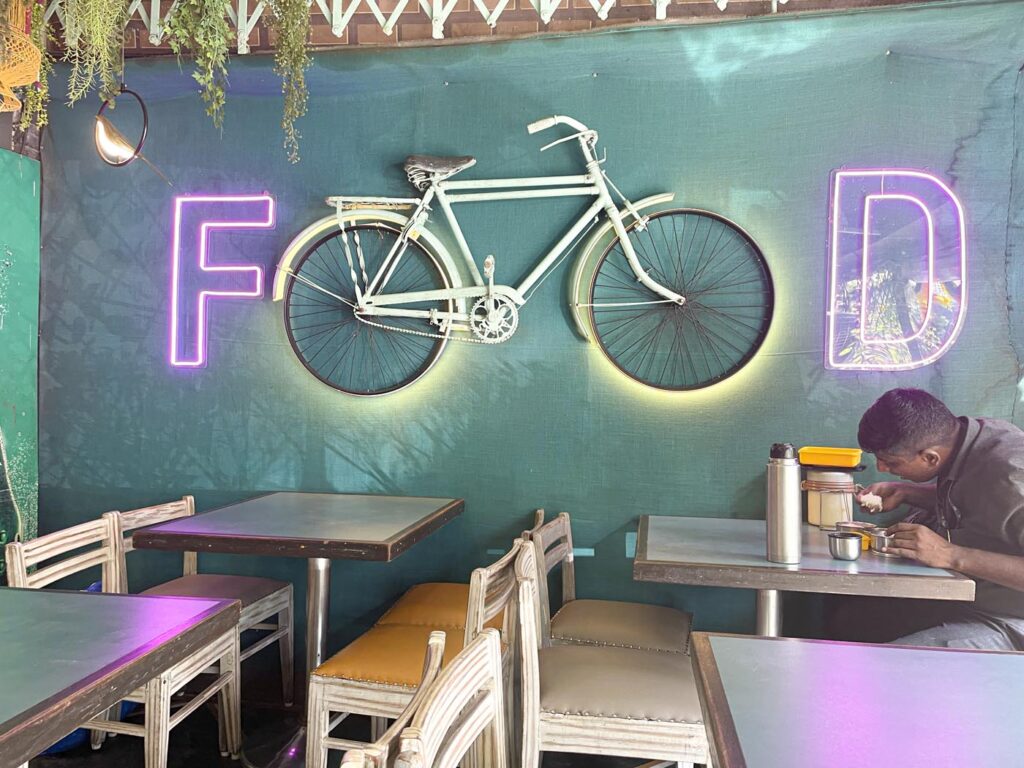The author’s journey exploring the diverse vegetarian dishes across India is a vibrant exploration of the country’s rich culinary heritage
By Lavina Melwani, New York
I have just come from Shiv Sagar, a humble vegetarian restaurant in Mumbai where every single day you get hundreds of choices, not only South Indian and North Indian, but also Jain, Mexican, pizza, veggie burgers and Chinese. There’s even an all-you-can-eat thali which is refilled free as fast as you can finish it! The South Indian menu alone numbers 74 options. Every item is pure vegetarian.
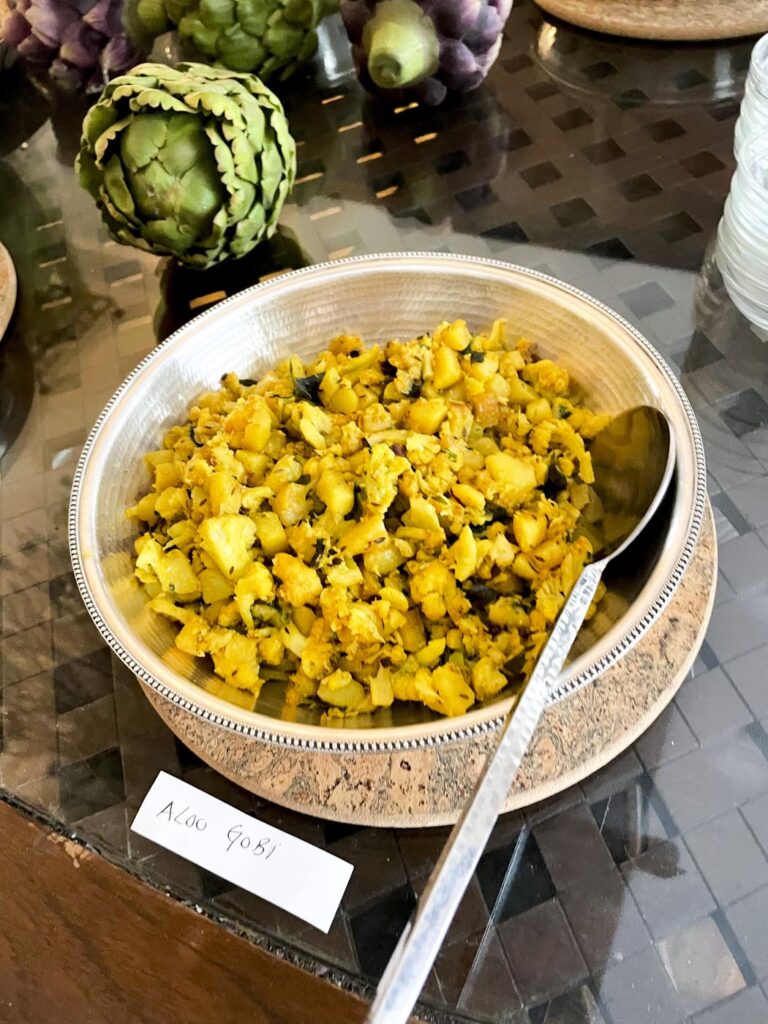
If I were to go back to India every single year for the next decade, I still would not be able to eat all the vegetarian special dishes that seem to crop up from the country’s rich heritage of past, present and future menus. Every time you open your mouth, you seem to be offered a new taste, a new fragrance and a new experience.
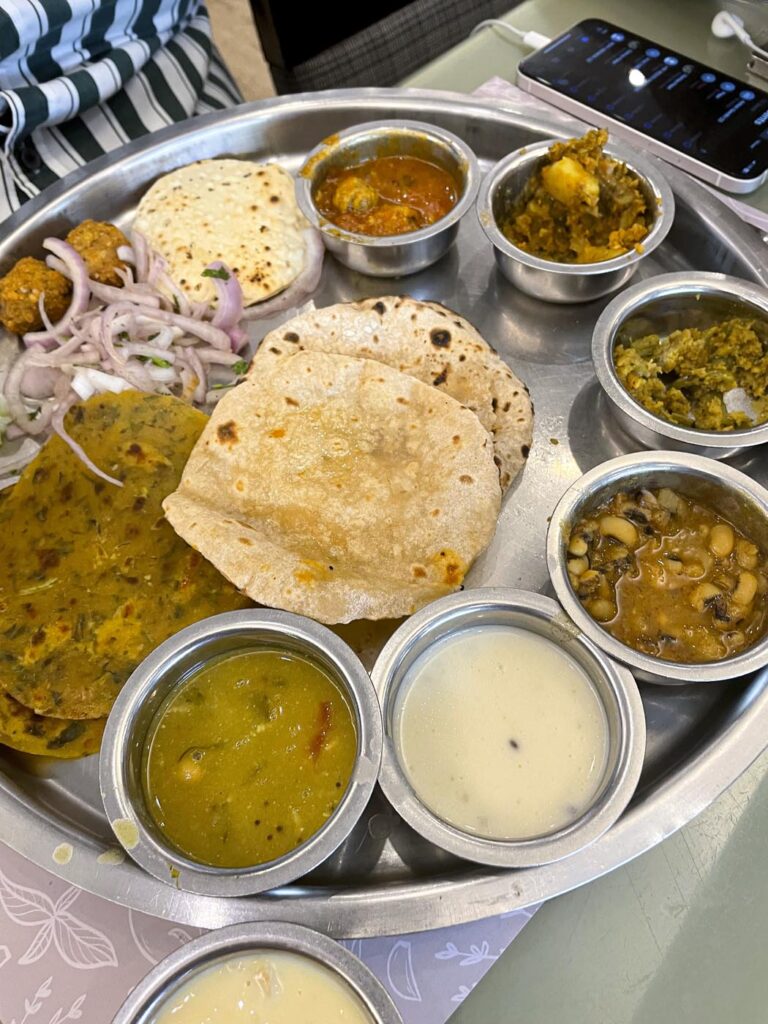
Indeed, for vegetarians, India is the globe’s largest Foodie Club, with hundreds and thousands of possibilities. In the US, in the old days, there were few vegetarian options except for salad, sides and—perhaps—veg pizza. Even now, some mainstream US restaurants offer only one vegetarian dish—take it or leave it.
The Food Stories of India
India means many things to Indians, but one powerful idea is food, especially food shared with family. For me, home food has always meant the joy of eating dishes cooked by mothers and grandmothers, as well as of old cooks who have been with the family for many years.
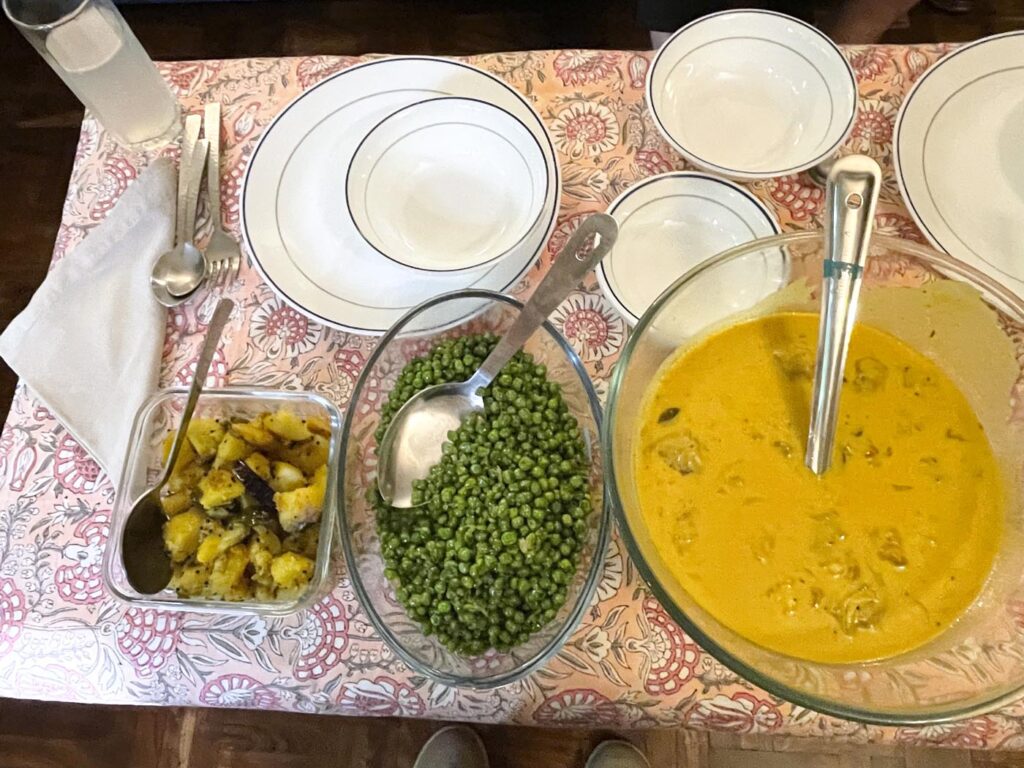
The best thing about India is the people you meet, and it is through them you learn so many unforgettable food stories. I ate at the home of a lovely 102-year-old woman who is full of zest and lives with her extended family in Bandra, a Mumbai suburb. The home is full of Ganeshas and good vibes. She starts the morning with a shloka from the Bhagavad Gita and makes herself a cup of chai. We ate a simple meal of daal, rice and spicy potato sabzi. She was so joyful and happy that the day could not but go well. She has lived a life of many ups and downs, yet she shows the true meaning of acceptance, karma and gratitude.

I also ate a grand meal with the rich and famous at a sparkling big fat Indian wedding in Delhi. It was an experience of rich people, rich food, rich jewels and general opulence. There were hundreds of dishes, both non-vegetarian and vegetarian, with a lineup from around the globe. Special stations held every kind of food, from appetizers to entrees and desserts. In the end, you were satiated because you can only eat what your stomach can digest!
On yet another day I ate in the company of bubbly, joyful schoolchildren in a slum colony in Delhi, and that was quite an experience, too. The cook had made the entire meal in an open-air, tin-shed kitchen for the 200 children, and we all ate the simple nutritious daal, rice and potato sabzi together. This is often the only full meal these children get in a day, and it was actually quite delicious: we found ourselves going for seconds.
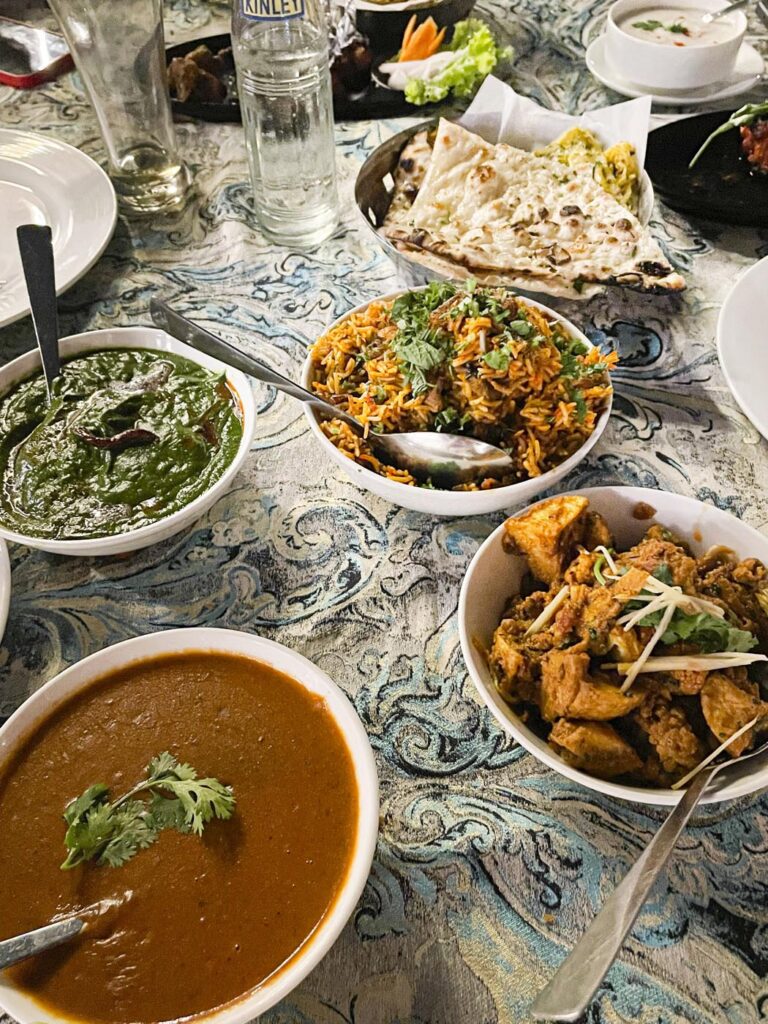
Then I ate with a childhood friend. Life had taken us through good times and bad, but here we were, survivors, eating all the home-made vegetarian Sindhi and Punjabi dishes that we loved, and exchanging notes while the cook kept bringing out fresh, puffy hot Gujarati rotis.
We drove to Palghar, 40 miles north of Mumbai, to visit a non-profit educational project. One of the delights in this area is eating at small roadside places, dhabas. Here we ate a delicious South Indian meal in the middle of a busy highway, topped with filtered coffee. Everywhere one went, food was always offered, even in a government municipal school, where we had gone to check on doing a partnership with them.
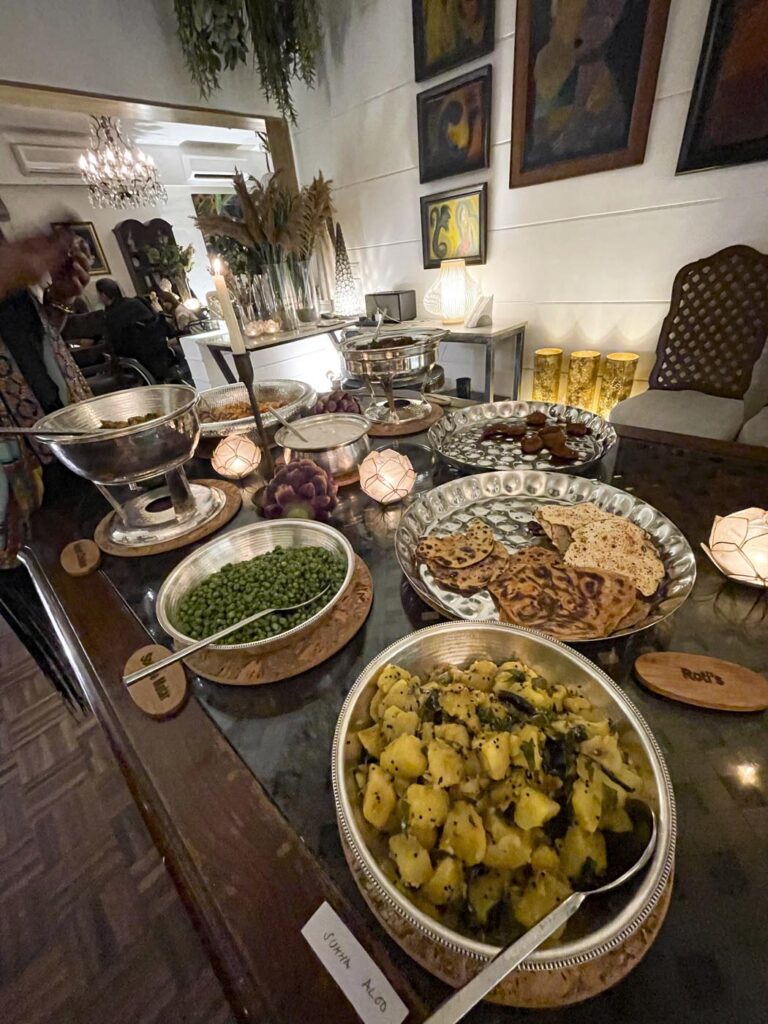
Food Shared with Family
I have memories of food that are decades old. I remember in my newly married sister’s home, how they would make traditional chunky Sindhi wheat rotis for dinner—the flatbreads would be flaky and rich with oil, served sizzling hot and already divided into two pieces so two family members could eat them instantly. They had somehow calculated that it takes a person a certain amount of time to eat just half, and so rather than let the other half get cold, it could be shared. Fresh hot ones would be coming to the table as people got ready to eat the second half.
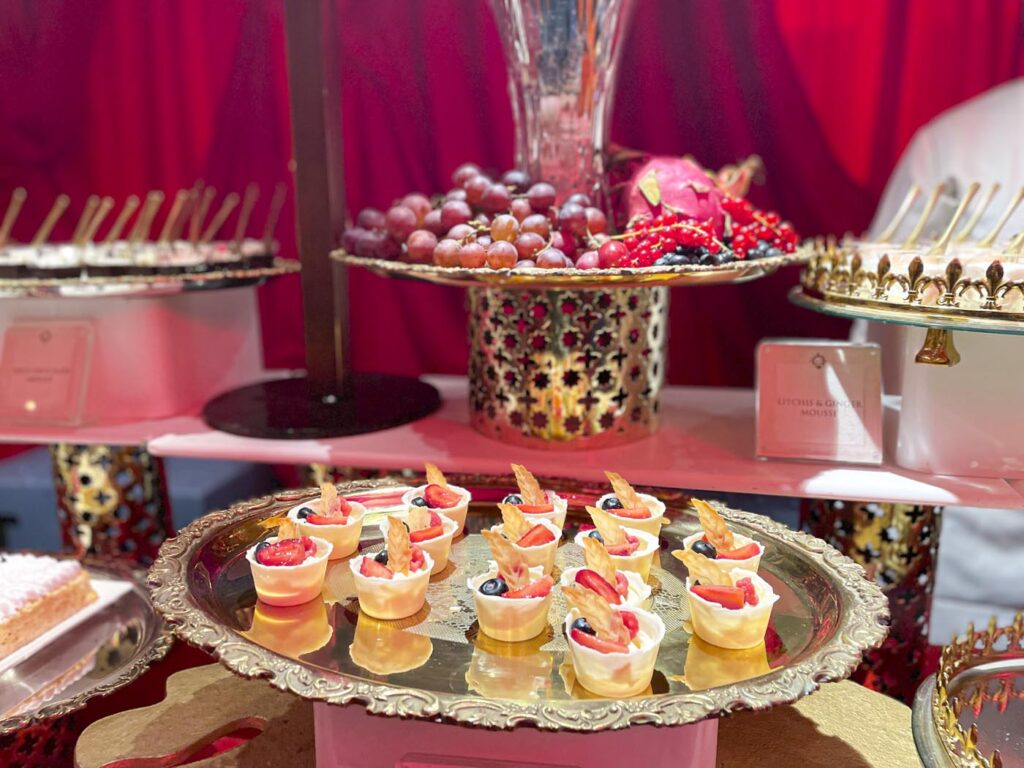
There’s Old Delhi, and there’s New Delhi, and all the little diasporas where you get Nepali, Naga, Tibetan and Chinese food, which is all part of the Great Indian feast. When close friends hear that you have come to the city, they often send the specialty of their home, so it’s like feasting every day without any real reason for celebration.

Growing up in Delhi, we were quite savvy about where you would get the best street food—sizzling aloo tikkis (potato patties) embedded with chana daal. The vendor would expertly grill the tikkis in a large tawa full of hot oil and then slash them in the middle, smearing on tamarind and mint chutney. We would go to the canteens near the sandstone fountains in India Gate to eat this delicacy. The other hot spot was in the by-lanes of Janpath in Connaught Place. It is always a delight to go back to Delhi and see how many of the old spots are still there.

Indeed, there’s no end to them. Delhi is embedded with chaat shops in all the suburbs like Green Park, Sunder Nagar and Greater Kailash, and everyone has their favorites. Their tasty treats, not costing a lot, have allowed the lower middle-class to join the foodie bandwagon.
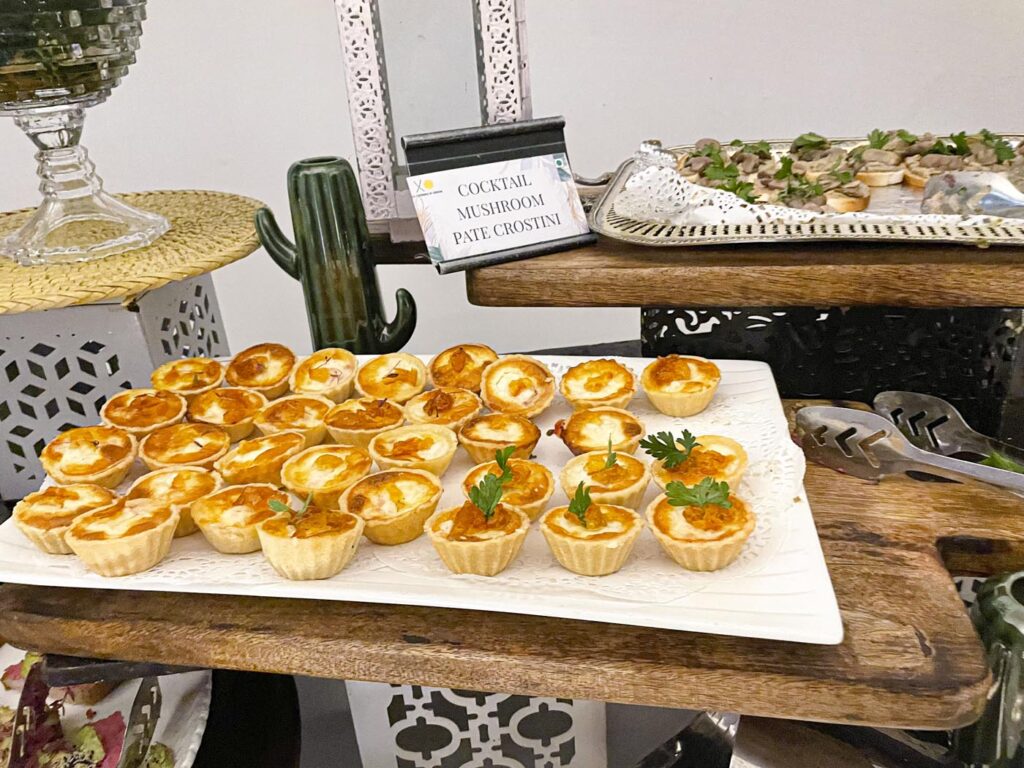
The British Raj in Delhi and Mumbai
And then there’s the treat both in Mumbai and Delhi, for people who are fortunate enough to be members of private clubs. It is a whole different thing, where—in the very British colonial style—the waiters keep bringing everything you ask for. Whether it’s cheese toast or cucumber sandwiches or peanut chaat, everything keeps coming. You also get coconut water in the shell right there. And to eat indoors in the club is to get every kind of meal, from European to Thai to Indian, and all that again at very reasonable club-subsidized prices.
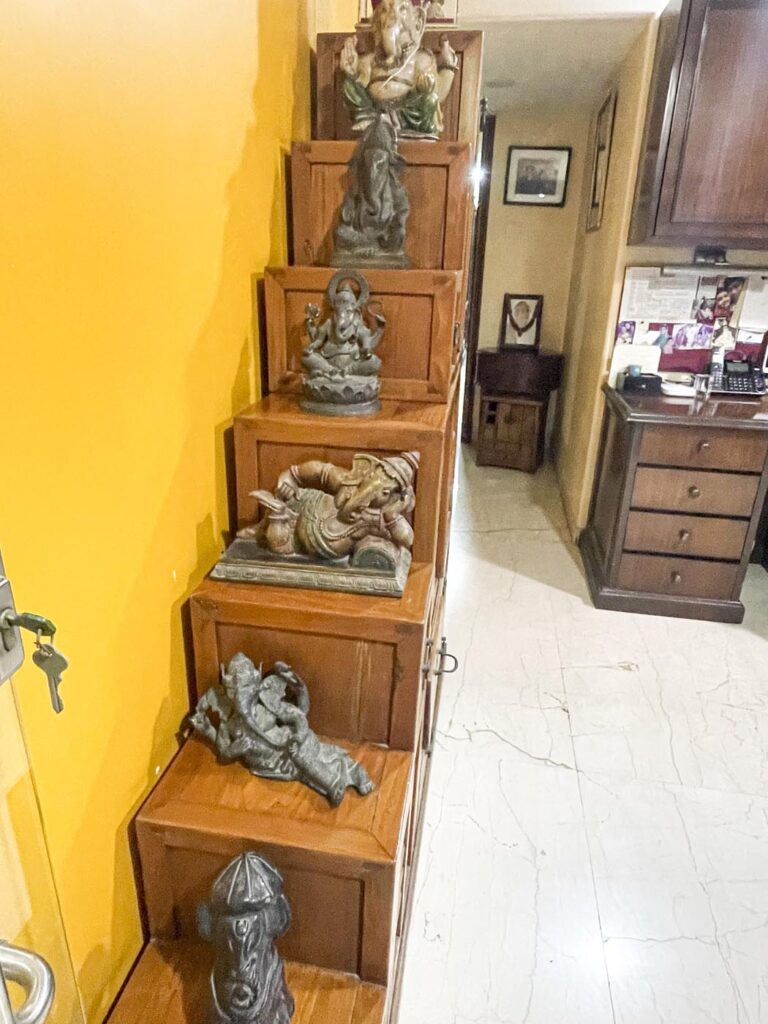
Eating In Versus Eating Out
Since most of the families I know have great cooks, a meal at home is a feast. Whether in Delhi or Mumbai, eating was always the highlight of the day. It can be something simple, whipped up at home, whatever our hearts desire, which is the wonderful thing about India, that you can just think of what you’d like to eat, and it’s immediately on the table. Here, in the end, the meals I enjoyed the most were the ones with the home touch. These big gatherings of the extended family at home had all the dishes that one could think of, with so many different ways of making even a simple thing like paneer. It was quite delicious eating the food of different hands, different home cooks, including things like Indonesian and Thai dishes. Delhi has become like a little New York, where all kinds of food are available, and women take pride in cooking themselves, or getting their cooks to make dishes for them. So many brides have settled in India from foreign lands that those cuisines are embedded in family favorites.
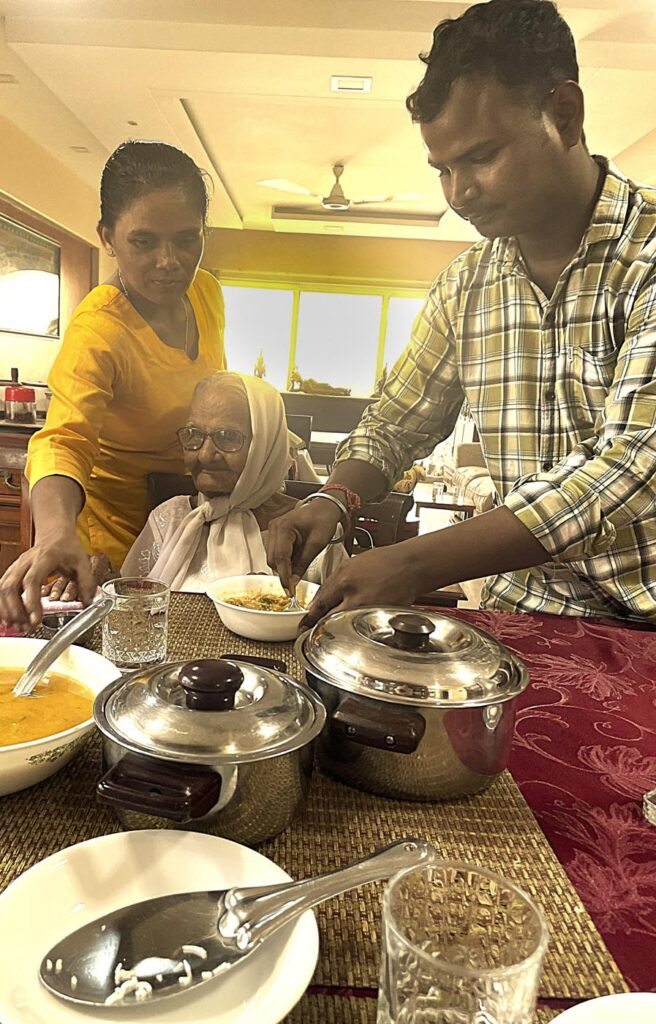
Another delight is to wander in the busy markets, like Lajpat Market or Khan Market in Delhi, and snack on everything from pao bhaji (butter-toasted bread rolls with vegetable curry, a Maharastrian favorite snack) to chikku-flavored ice-cream. There’s lots to take back home, be it dried fruit or papads. It was funny meeting an Indian-American family in a crowded Delhi market, who were also tasting the nuts to see if they wanted to take them all the way back to America. Normally, the quality is supposed to be excellent because these nuts come from Afghanistan. But here, the Indian-American man tried a few and he said he much prefers Costco! Travelers bring their own prejudices and likes into the story.
Eating Like a Mumbaikar
On this trip my main attraction was merging into the marketplace with regular Mumbaikars, and buying regular things like clay diya lamps and papayas. In these crowded thoroughfares, green chilies, limes and coriander are laid out like emeralds on a sheet, and bargaining is the order of the day. There is a lot of drama and play-acting between the vendor and the buyer, and the battles are quite drawn out, yet everybody leaves happy.
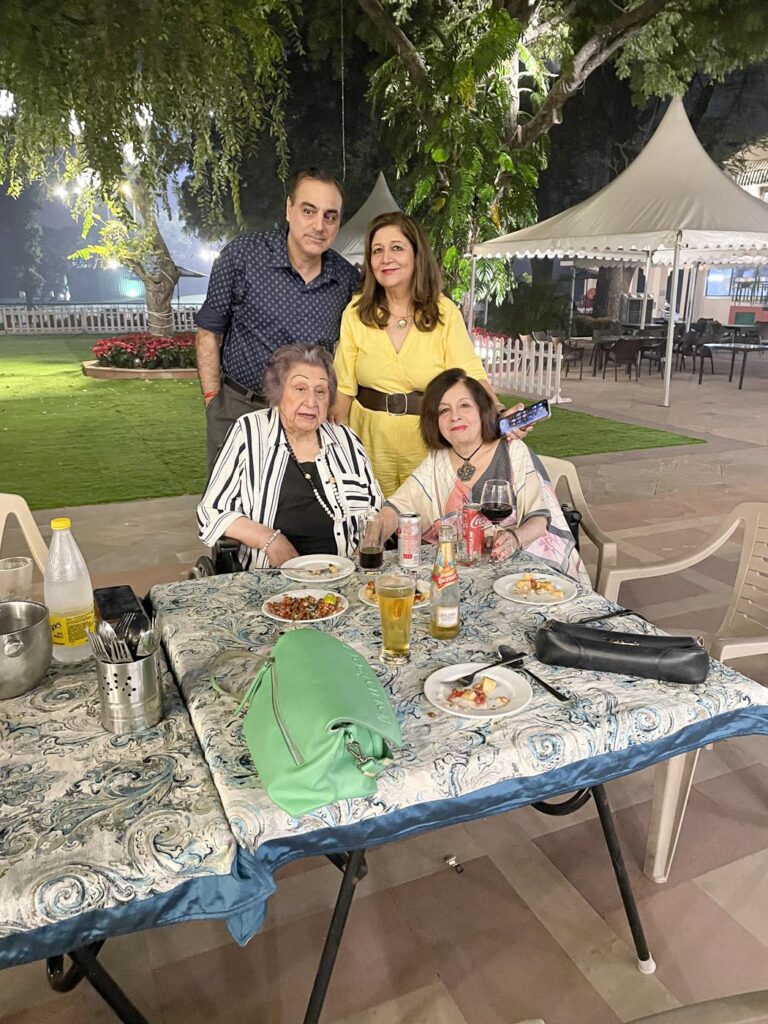
I also love the idea of a kirana shop, a neighborhood store where everything is available, whether you want fresh vegetables, fruit, diet foods, snacks, packaged food—everything is there. The place seems like a warren, but they know exactly where everything is kept, and will get you just about anything you need. They will even deliver at odd times of the day and night.
But the biggest delights of Mumbai were the simple people’s restaurants, like Samrat, Status and the Shiv Sagar chain, specializing in vegetarian food, often the all-you-can-eat Gujarati or Rajasthani thali. In Delhi, I had eaten at Andhra Bhavan, which is a dream come true for lovers of South Indian food where you can eat as much as you want of dosas and idlis for a pittance. Shiv Sagar in Mumbai, with all cuisines under one roof, is where everyman is king—with a menu that boasts more than you can ever eat, including paneer served in every form imaginable, from Punjabi to Chinese to Italian. It was a delight to see whole families gathered together, business associates, too, all having a good meal without emptying their pocketbooks. I also ventured to Soam, a small place in Chowpatty, to try Kathiawadi. This is a fiery and spicy cuisine within the larger more bland Gujarati cuisine that uses a lot of garlic, onions and spices. It was a new experience for me.
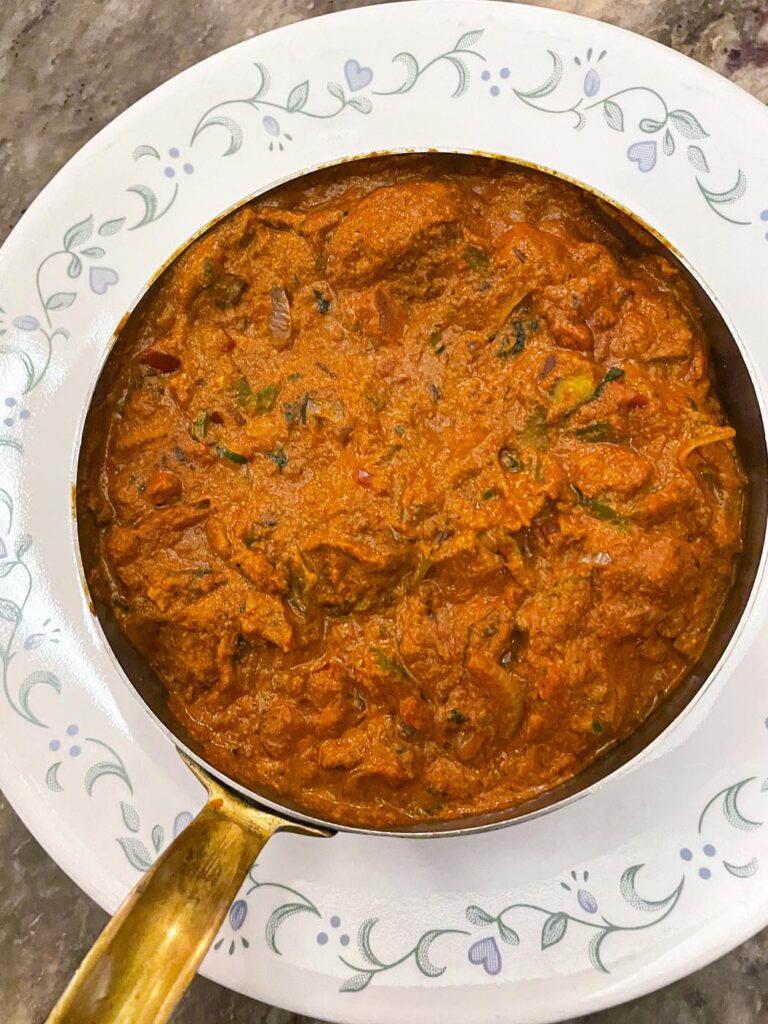
The Hospitality of India
To go to anybody’s house at teatime means getting a whole lineup of things, including namkeens, which are salty snacks, sandwiches and some mithai. Often they make the grand gesture of giving you a box of the sweets. Food is very much a part of every ritual, a cup of chai and some snack is always given, no matter where you go. Even a simple villager will offer you at least a clay cup of hot chai and maybe a small package of precious glaxo biscuits.
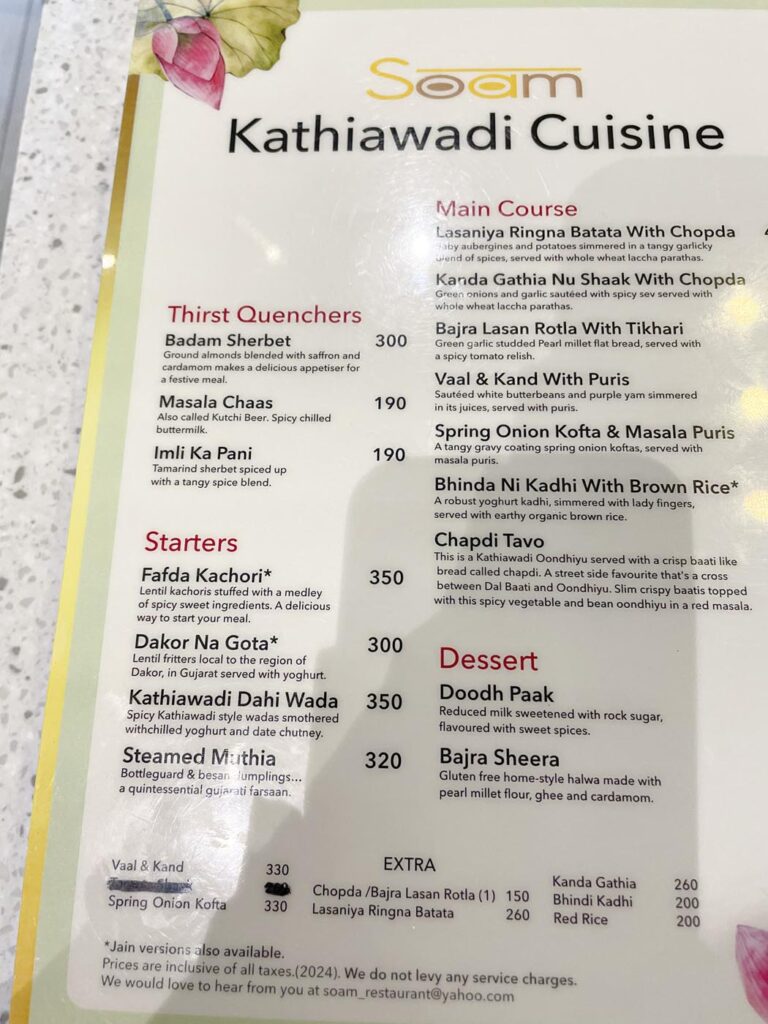
The trouble is that in India a stay of a month is nothing. You need a lifetime of eating—and even then, you would not have tried every dish there is. Here I have not even mentioned the countless temples where, no matter which one you go to, there’s always prasadam. You cannot come away without being given something sweet and delightful by the Almighty to bless your day.
A once-starving nation has now become a self-sufficient, unending food basket which contributes to other nations. God certainly has blessed the Indians with great culinary talents for utilizing their wholesome grains and lentils and vegetables to create an unending array of healthy dishes. Indian women seem to be instinctive cooks, having learned from their mothers and grandmothers before them, and Indian men who cook for a living have used all the tricks of the trade to create every kind of meal, from simple to princely, to keep eaters engaged and happy.
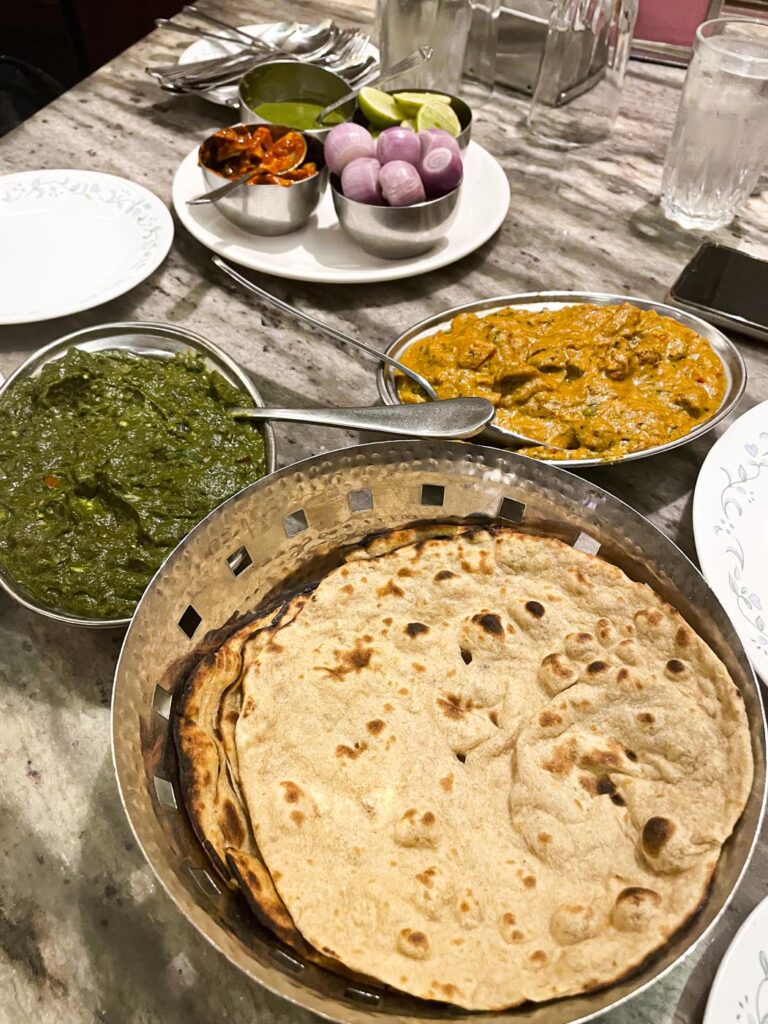
Indian cooks give you just what you need, when you need it—especially soothing daals, rice and vegetarian snacks with wonderful comfort. Even at home, the feasting never stops. Different kinds of desserts are served. Then there’s tea from Assam, coffee from the South, lassi from Punjab, sweet rose syrups and sugar cane juice. And you can’t possibly refuse that homemade laddoo! You can’t say no to that last piece of mithai! In the end, you have to raise your hands in helpless surrender. Enough is enough!
